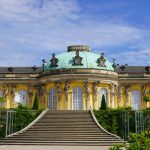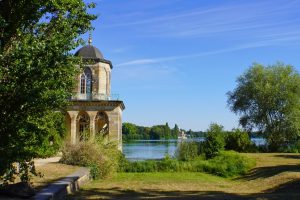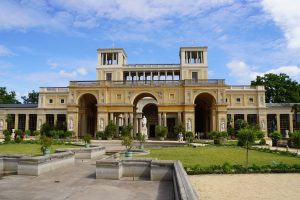At the Alter Markt in Potsdam stands the imposing building of the Protestant church of St. Nikolai, popularly known simply as the Nikolai Church. The highlight of a visit to the church is the ascent to the dome, which offers a great view of Potsdam.
History of the Nikolai Church
Where the church building of the Nikolai Church stands today, a church is said to have already stood in the 13th century. However, little is known about this church. In the 14th century, the existing nave was converted into a three-nave Gothic hall church. The church, which was Catholic at the time, was subordinate to the provostship of Spandau.
In 1539, the Reformation took hold in Brandenburg under Elector Joachim II Hector and this church building also underwent a change of confession. It was rebuilt several times and in 1563 the building was given a Renaissance dome on the romantic tower.
New church building and renaming
Over time, Potsdam developed into an up-and-coming residential and garrison city. It soon became apparent that the church building (at that time the church was still called Katharinenkirche) was too small. It was demolished in 1721 so that a new baroque building could be erected. The new church was dedicated to St. Nicholas. The new church, designed by the master builder Philipp Gerlach, had the ground plan of a Greek cross and a bell tower almost 90 metres high.
After coming to power, Friedrich the Great began to redesign the city, which had previously been quite functional, in a representative manner. The buildings around the Old Market Square were to be designed to resemble an Italian piazza. The Nikolai Church was also given a new façade on the market side in the course of the redesign. The façade was designed in the style of the Roman late baroque and structured by columns and essays. A fresco decorated the upper part of the central axis.

The Nikolai Church did not stand for long. In September 1795, it burnt out completely during repair work in the tower and shortly afterwards the ruins were removed. Only the façade remained standing.
New building the second
Friedrich Wilhelm II commissioned plans for a new building quickly after the fire. However, these were forgotten after the ruler died and the lost battle against Napoleon and the subsequent financial crisis did not allow for a new building. In 1811, the façade was removed and a green area was laid out on the site of the church.
With the improvement of the city’s economic situation, work began on the new planning of the Nikolai Church. Karl Friedrich Schinkel was commissioned as architect to draw up designs. However, the financial means were initially only sufficient for the construction of the substructure; the planned dome had to wait. Already in the construction phase, there were some technical construction errors that had to be corrected. The client was dissatisfied and the church was consecrated in September 1837 without Schinkel’s presence.
Schinkel died in 1841 and did not live to see King Friedrich Wilhelm IV order the original plan for the Nikolai Church to be implemented and the dome to be built in 1843. For this purpose, the commissioned architect erected additional tower-like superstructures for structural reasons and began work on the dome in 1845. After about 5 years of construction, the church now shone in a new look.
Church history since 1945
During the Second World War, there was a large-scale air raid on Potsdam in April 1945. Large parts of the city were destroyed, but the Nikolaikirche remained almost intact. It was not until the end of April that the dome and the entrance portico collapsed during fighting and the associated artillery fire. The interior of the church was also badly damaged, with only the altar and pulpit remaining undamaged.

It was to take a while before services could be held in the church again. At first, only makeshift protection was carried out to prevent the danger of collapse and the ingress of water.
Then, from 1955, the reconstruction took place in several sections. During this work, members of the church council managed to hide a cassette with documents in the sphere on the dome. In 2006, the contents of the documents became known, describing the persecution and unlawful arrest of church members by the GDR state power.
In May 1981, the construction work was completed and the Nikolai Church could be consecrated.
Tour around the Nikolai Church
The Nikolai Church is a cubic building with a flight of steps in front of it on the south side. The apse lies to the north. The square base is topped by 45-metre high buttress towers at the corners. Statues of angels sit on them. In three of the four towers there is a round arch opening on the top floor in which bells hang. In the fourth tower, a staircase leads to the viewing platform.
If you take a closer look at the south side of the Nikolai Church, you will discover a columned portico next to the flight of steps. A total of six columns support the tympanum (decorative surface) under the gable roof. Here is a reconstruction of the relief destroyed in 1945, which shows a motif from the Sermon on the Mount. Below the main cornice are words from the Sermon on the Mount. The individual lines are separated from each other by angel figures.

Under the portico is the entrance to the Nikolai Church, which consists of two small and one large door.
The west and east façades are designed with tall mullioned windows and a stained glass semi-circular window.
The church’s tambour dome rises on the church’s substructure.
The dome of the Nikolai Church

The dome rises on the substructure. It is called a tambour dome and has a height of over 22 metres. The tambour is surrounded by 28 Corinthian columns, which have a height of 10 metres. In the lower section, 14 mullioned windows let daylight into the church. On top of the tambour is the double-shelled dome of the Nikolai Church, which has a diameter of 24 metres and a height of 13 metres. The outer dome is covered with copper plates. A lantern resting on seven columns and a spherical cross rise on the dome.
The Ascent
We visited the viewing platform at a height of 42 metres at the portico.
During our visit, it was possible to buy the ticket for the ascent in the entrance area. However, there is also a vending machine in the gallery, which can be reached via a staircase.

From the gallery you can look into the Nikolai Church (this is possible free of charge). There are dark wooden benches in the church and you have a great view of the slightly raised choir with pulpit, organ and baptismal font. Behind this is the apse with a superstructure resting on columns above an altar. The apse is painted. On a golden background are the twelve apostles and above them the evangelists Mark, John, Matthew and Luke. Originally there was a picture of Jesus on the throne of heaven above. This image has not been reconstructed.

The view into the mighty dome of the church is particularly beautiful. Directly at the transition between the substructure and the tambour, images of the Old Testament prophets are depicted in medallions. The dome itself is rather plain, but impresses with the incident light and the height.
After passing a turnstile where you have to scan your ticket, you can start the ascent. Scanning the entrance ticket proved to be “difficult” during our visit – although we were probably just too impatient until the second ticket could be read. It took what felt like an eternity before a clearance was given. Other visitors were not so patient and climbed over the turnstile.

We then climbed 216 steps via a narrow spiral staircase. You don’t necessarily want oncoming traffic here. There are also traffic lights, but they did not work during our visit.

The viewing platform has been located on the portico at a height of about 42 metres since 2010. The view is impressive. You have a great view of the Havel landscape and, of course, of Potsdam. You can look out over the Old Market Square and discover the Fortuna Portal, the Potsdam Museum – Forum for Art and History and the Museum Barberini.


Address:
Am Alten Markt,
14467 Potsdam
Opening hours (church tour and tower ascent for a fee)
Monday, Tuesday: closed
Wednesday- Saturday: 9:30 am – 5:30 pm
Sunday: church tour from 11:30 a.m., tower ascent from 12:00 p.m.
Admission fee:
Adults: 5,-€
















Leave a Reply